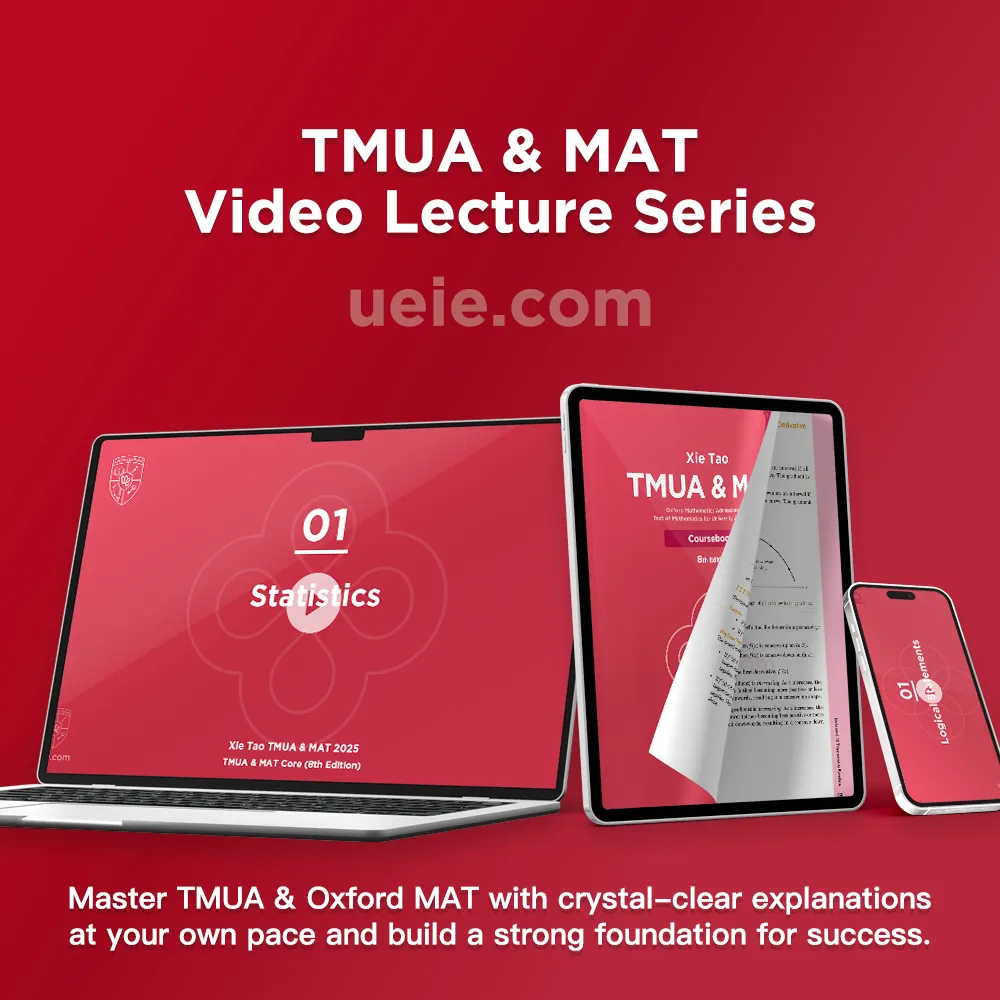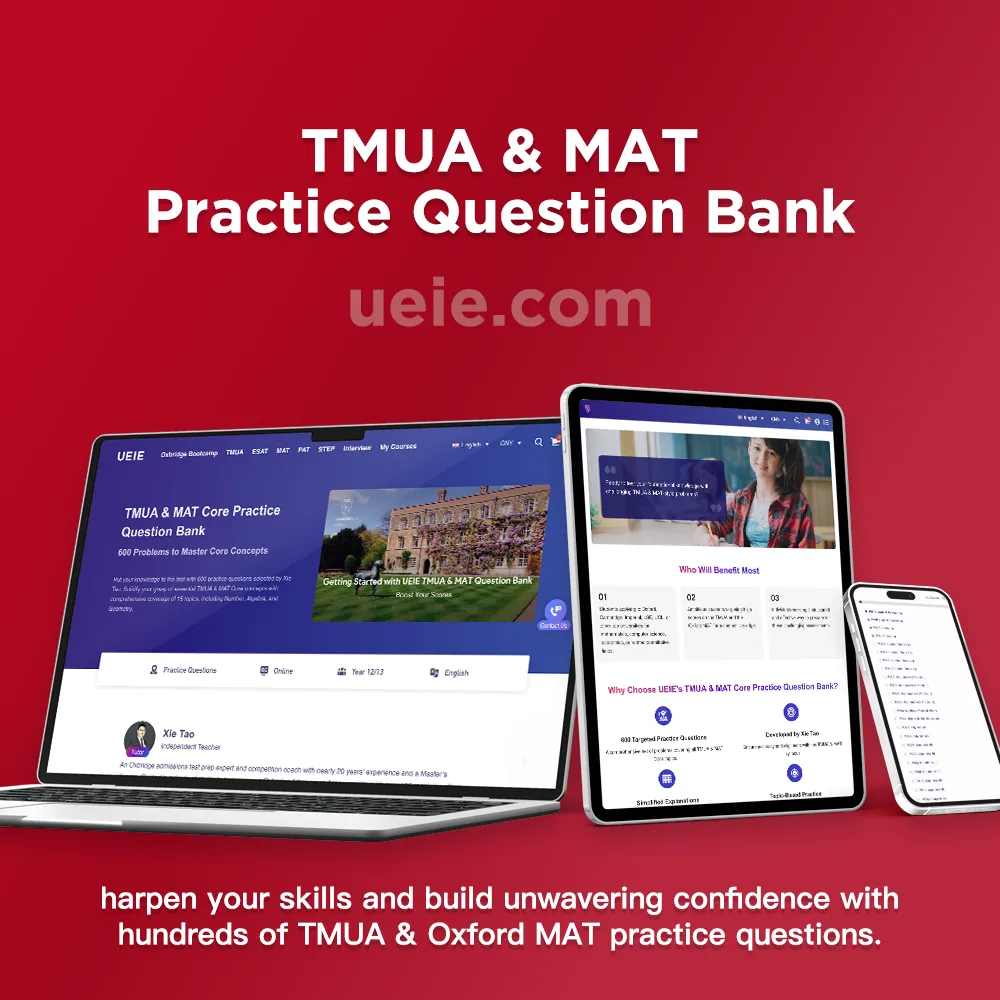Conquer the TMUA: Speed & Accuracy Training for Top Maths Scores

Independent Teacher
Conquer the TMUA: Speed & Accuracy Training for Top Maths Scores

Preparing for the TMUA test can often leave students feeling uncertain: How much preparation time is really needed? How can I effectively improve my speed and accuracy? Which study methods will work best for me? This TMUA Preparation Guide aims to address questions like these.
This guide draws on my years of practical experience and insights gained from coaching students for Oxbridge admissions tests and mathematics competitions. It focuses on how to set realistic preparation goals, develop the core mathematical abilities needed for TMUA, employ effective study strategies, plan your preparation time sensibly, make the best use of various resources, and sidestep common preparation pitfalls.
Before you dive into this guide, it’s a good idea to familiarise yourself with the basics of the exam by reading the TMUA Comprehensive Guide.
I. Setting Goals and Adjusting Your Mindset for TMUA Preparation
Getting started with your TMUA preparation first requires a clear sense of direction and some self-awareness. Setting sensible goals and having the right mindset will provide a solid foundation for your subsequent systematic preparation.
1. Clarify Target Requirements
What specific TMUA score does your chosen university and course require? Roughly what score range is considered competitive? This information essentially sets your target. Please carefully check your target university’s official website. Confirm the latest admission requirements for your application year. (You can find an overview of this information in Section III of the TMUA Comprehensive Guide.)
2. Conduct a Preliminary Self-Assessment
Before formally starting your systematic preparation, taking a diagnostic test (a baseline test) to gauge your starting point is crucial. This helps you to:
- Get a feel for the style of TMUA questions, the time pressure involved, and the actual difficulty level.
- Get an initial idea of your current mathematical proficiency and where the gaps lie compared to what TMUA requires.
3. How to Conduct a Diagnostic Test?
- Choosing a Test
- You could use official past papers from earlier years for a practice run.
- Recommended Approach: To help you get a more accurate and comprehensive self-assessment, based on years of research into the TMUA exam, I (Teacher Xie Tao) have created a dedicated Free TMUA Diagnostic Exam (online computer-based). This test reflects the latest TMUA syllabus and difficulty standards, designed to more effectively assess the core knowledge and skills needed for TMUA. Click the link below for more details and to take the test online.
- UEIE Free TMUA Diagnostic Exam
- Taking the Test
- Environment: Whichever paper you use, you should replicate real exam conditions as closely as possible (online computer-based or a quiet paper-based setting) and complete it on your own.
- Timing: Time Paper 1 and Paper 2 separately, sticking strictly to the 75-minute limit for each.
- Marking: Use the official marking scheme or the reference answers and marking guide provided with the diagnostic test to mark it objectively.
- Result Interpretation and Mindset: Remember, this initial score is just a baseline. The aim is to see where you stand, not to predict your final score. What matters is analysing your mistakes and identifying weak spots. Keep hold of your paper and analysis to track your progress later.
4. Setting Realistic TMUA Score Goals
Once you understand the target requirements and your own starting point, the next step is to set sensible, achievable TMUA preparation goals.
- Understanding Scores
Remember, TMUA’s 9.0-scale standard score needs to be seen in context – considering both university requirements and the overall competition. Please refer to the analysis of competitiveness across different score bands (e.g., 4.5, 7.0, 8.0+) in Section VI of the TMUA Comprehensive Guide to get a sense of where your target score sits. - Setting SMART Goals
Based on your diagnostic test results, target university requirements, and the time you can realistically commit, set goals that are Specific, Measurable, Achievable, Relevant, and Time-bound (SMART).
For instance: ‘My target is a score of 7.0 in the October TMUA test. To get there, over the next four months, I aim to consistently achieve a raw score of 32 (which converts to roughly 7.0) in practice mocks, while completing each paper within the 75-minute limit.’ - Balancing Ambition with Realism
Your goals need to be challenging enough to push you, but they must also be realistic given your assessment and available time, ensuring they are achievable with effort. Setting overly ambitious goals can easily lead to frustration, which can put you off. It’s also fine, and often necessary, to adjust your goals as you go along based on your progress.
II. Knowledge Foundation Required for TMUA Preparation
To prepare successfully for TMUA, you first need a clear picture of the knowledge the exam requires and understand how this applies to you (e.g., whether you’ve finished A Level Maths, or if you’re studying AP/IB).
1. TMUA Requirements regarding A Level Knowledge
As mentioned in Section VII, TMUA Syllabus Overview, of the TMUA Comprehensive Guide, the TMUA syllabus is primarily based on AS Level Mathematics content, along with some topics from GCSE Mathematics. Therefore, a solid grasp of the relevant AS and GCSE Maths content is essential.
2. Is it Necessary to Study A Level Further Mathematics in Advance?
No, it’s not required. The TMUA syllabus content doesn’t go beyond AS Maths and GCSE. However, in terms of deepening your mathematical thinking and getting ready for university interviews and future study, I strongly recommend studying A Level Further Mathematics if you have the time and capacity. Although not directly tested, the thinking skills and broader knowledge it develops are very useful for tackling some tricky TMUA problems and for your studies later on.
3. Is a Foundation in Mathematics Competitions Necessary?
It helps, but isn’t essential. Recently, some TMUA questions have shown a style and difficulty similar to maths competitions, occasionally using basic knowledge and methods common in competitions (like number theory, basic combinatorics, recursive thinking). Consequently, students with competition experience might have a slight advantage with certain difficult problems. For students without this background, don’t worry too much; the core of TMUA is still about applying the syllabus knowledge proficiently. However, during your preparation, if you come across questions with this flavour, it can be helpful to look into some basic competition concepts and techniques to broaden your skills.
4. Knowledge Alignment for Students from Different Curriculum Systems
Students studying AP or IB need to be aware of how the coverage differs and prepare accordingly.
- Advice for AP Students: AP Calculus AB or BC provides a good grounding for much of the pure maths needed for TMUA Paper 1 (especially calculus). However, be aware that TMUA expects more proficiency in sketching graphs by hand, whereas AP Calculus focuses more on using graphic calculators. Therefore, this might need specific practice.
- Advice for IB Students: Compared to the TMUA syllabus, IB Maths HL (both AA and AI) might not cover certain topics or go into the same breadth in pure maths and statistics. Furthermore, the emphasis on basic calculation and algebraic skills might also be different from what TMUA expects. Combined with the often demanding workload of the IB programme, students doing the IB often find TMUA more challenging.
III. Core Abilities Essential for High TMUA Scores
Mastering the required knowledge base is the first step, but to achieve a high score in TMUA, you also need to sharpen the following core skills, which are crucial given the test format (multiple-choice, tight time limits).
1. Calculation Speed and Precision
- Core Requirement
- You can’t use a calculator at any point in the TMUA, and the timing is extremely tight (less than 4 minutes per question on average). This presents a double challenge: you need speed, and critically, accuracy. In a multiple-choice format, any calculation slip-up can lead directly to lost marks, with no marks given for your working.
- Key Areas for Improvement
- Sharpening Basic Calculations: Get completely fluent with mental maths and written calculation techniques, especially for common values, formulas, algebraic manipulations, differentiation, integration, etc., until it’s almost second nature.
- Practising for Speed: Make a point of practising calculations under timed conditions without a calculator to improve how much you can accurately get done in a set time.
- Prioritising Precision: Get into the habit of being careful and checking your work, particularly with multiple-choice questions, where small errors can easily lead you to pick the wrong answer (a ‘distractor’).
2. Agility in Mathematical Reasoning
- Core Requirement
- Particularly in Paper 2 (Mathematical Reasoning), the test doesn’t just assess logical rigour, but also how quickly you can understand, apply, and evaluate mathematical logic and proofs under pressure. You need to quickly spot the logical connections within problems and identify valid arguments or common mistakes in reasoning.
- Key Areas for Improvement
- Understanding Logical Terms: Make sure you precisely understand terms like sufficient, necessary, if and only if, and negation.
- Recognising Patterns: Practise quickly spotting common proof structures (like the beginning of a proof by contradiction or the structure of induction) so you can grasp their core logic, even if you don’t need to write the full proof.
- Spotting Errors Quickly: Focus on practising how to spot potential logical flaws or incorrect steps in mathematical arguments.
- Getting to the Crux: Practise quickly identifying the main line of reasoning within complex descriptions or mathematical statements.
3. Multiple-Choice Test Strategies and Techniques
- Core Requirement
- As TMUA is purely multiple-choice, knowing effective test-taking strategies is just as important as knowing the maths itself. High scorers are often good at using different techniques flexibly to maximise their score in the limited time. Plus, when faced with unusual question types or phrasing, you need to be adaptable.
- Mastering Multiple-Choice Techniques:
- Process of Elimination: Get good at using elimination to quickly narrow down the possible answers.
- Using Special Cases: Try plugging in special values or considering extreme situations to check or rule out options.
- Estimation & Checking Units: For some questions, check if options are plausible by estimating the magnitude or checking the units.
- Working Backwards: Sometimes plugging the answers back into the question is quicker than working forwards to the solution.
- Managing Your Time:
- Quick Decisions: Practise quickly judging how hard a question is, so you can decide whether to tackle it now, leave it for later, or just make a guess. Avoid getting bogged down on difficult problems.
- Marking Questions: Mark questions you’re unsure about so you can come back to them if you have time at the end.
- Being Adaptable: Get better at handling unusual question types by practising problems from different sources and in different styles (including some competition-style problems).
- To sum up, scoring well in TMUA means being able to calculate quickly and accurately, reason logically and swiftly, and use smart multiple-choice strategies, all under pressure. Developing all three of these skills is key to your TMUA test preparation.
IV. Core Preparation Strategy and Resource Integration
1. Core Principle: Fluency, Precision, and Speed
Unlike STEP, which focuses on deep exploration, the core of TMUA test preparation is getting extremely fluent with the syllabus material and being precise and quick under pressure. Since only a limited number of official past papers have been released, simply drilling these isn’t enough. Successful preparation must be built on solid knowledge fluency, backed up by plenty of targeted practice to sharpen your speed, accuracy, and test-taking technique.
2. Phase 1: Building Fluency and Consolidating Knowledge
Goal
- Go through all the AS and GCSE Maths topics covered by the TMUA syllabus, making sure you know them fluently and can recall them quickly. The focus here is on strengthening your foundations and improving calculation speed and accuracy.
Actions and Resources
- Check the Syllabus: Use the latest official syllabus as your guide, going through the topics one by one to ensure nothing is missed.
- Systematic Revision: Use your AS/GCSE textbooks or resources like MEI to revise or consolidate basic concepts and methods.
- Practise the Basics: Do plenty of targeted practice with basic and standard problems, focusing on getting fluent and accurate with algebraic manipulation, properties of functions, basic calculus, and so on.
- Using UEIE Prep Resources: The TMUA Video Lecture Series (with textbook) and TMUA Practice Question Bank can offer systematic topic reviews, explanations of key points, and basic examples during this phase.

TMUA & MAT Video Lecture Series
¥4,980 – ¥5,980Price range: ¥4,980 through ¥5,980
3. Phase 2: Targeted Skill Training and Technique Refinement
Goal
- Focus on the specific types of questions and skills TMUA tests. Improve your speed, use of multiple-choice strategies, and quick mathematical thinking. Make up for the lack of official past papers.
Actions and Resources
- Analysing Official Materials: Use the limited official sample questions and past papers strategically. Analyse every question in detail, focusing on the approach, common traps, and time allocation. Use the official explanations to understand key techniques.
- Targeted Practice: You’ll need good quality extra practice resources. The TMUA Practice Question Bank contains loads of practice questions and is key for this stage, allowing for high-intensity, timed training by question type or topic.
- Refining Techniques: Consciously practise using multiple-choice techniques (elimination, substitution, estimation, etc.), and figure out which methods work best for you.
- Tackling Harder Problems: For challenging problems in official papers or practice sets, use the explanations for difficult problems in the TMUA Video Lecture Series to learn efficient methods and ways of thinking.

TMUA & MAT Practice Question Bank
¥4,680 Original price was: ¥4,680.¥3,898Current price is: ¥3,898.
4. Phase 3: Mock Exams and Final Adjustments
Goal
- Fully replicate exam conditions to test your overall level, fine-tune your test-taking strategy, and get into peak condition for the exam.
Actions and Resources
- Sitting Full Mocks: Use the latest official samples, past papers you haven’t done yet, or good quality mock tests (like the UEIE TMUA Full-Length Mock Exams) under strict timing (75+75 minutes) without interruptions. Aim to do at least 3 mocks.
- Testing Your Strategy: Check your approach to choosing questions, managing time, pacing yourself, and using multiple-choice techniques under pressure.
- Addressing Weaknesses & Mindset: Analyse any problems the mocks reveal and do some final targeted practice. Adjust your mindset and build confidence.
5. Advice on Choosing TMUA Preparation Resources
Official Materials:
- The UAT-UK official syllabus, sample questions, and released past papers are essential materials you must work through thoroughly.
Supplementing Official Materials:
- Given the limited official past papers, good quality extra practice resources with plenty of questions (like dedicated practice sets or online platforms) are crucial for TMUA preparation.
Choosing Wisely:
- Use other resources (like MEI, relevant books, online forums) selectively based on your needs; avoid getting overloaded with information and stick to core training.
The UEIE TMUA Test Preparation Solution:
- Designed to tackle the common problems in TMUA prep – like the lack of official papers and the need for lots of targeted practice and effective score-boosting strategies – I developed the UEIE Education TMUA preparation series based on years of experience. This solution includes:
- TMUA Video Lecture Series (with PDF textbook): Systematically explains key syllabus points, tricky areas, and problem-solving strategies.
- TMUA Practice Question Bank (Online): Provides far more practice questions than the official papers offer, categorised by topic and difficulty, filling the gap left by the limited past papers.
- TMUA Full-Length Mock Exams: A total of 8 mock exams, providing a complete learning and testing cycle.
- These materials are updated annually (currently the 2025 8th Edition), keeping them up-to-date with exam trends. They aim to help students improve preparation efficiency and enhance the fluency, speed, and accuracy needed for TMUA, helping you aim for your target score. Click to browse the TMUA Prep Hub—Courses, Practice Set & More Resources.
V. How to Plan TMUA Preparation Time?
‘How long do I need to prepare for TMUA?’ There’s no single answer to this, as it varies from person to person. Unlike STEP’s long cycle and focus on depth, the TMUA preparation cycle is generally shorter but demands extremely high intensity and efficiency in training specific skills.
1. Key Factors
How long you’ll need mainly depends on:
- Target Score Band: Are you aiming for 6.5, 7.0, or even higher? Higher targets usually mean more time spent practising and higher intensity training.
- Starting Proficiency: How solid is your current understanding of AS/GCSE knowledge? How are your calculation speed and accuracy? (Refer back to the self-assessment in Section I).
- Weekly Time Commitment: How many hours of focused study can you realistically commit to each week?
While there isn’t a specific ‘300-400 hour’ guideline like for STEP, reaching the higher TMUA scores still demands plenty of focused, efficient practice.
2. Suggested Timelines Based on Starting Point
Based on typical student profiles, here are some suggested start times and timelines:
- Strong Foundation (e.g., STEP Grade 2+ level, or AIME/BMO 1 competition experience): The main focus is adapting to the multiple-choice format, the speed required, and Paper 2’s logical reasoning style. Starting focused training around 2-3 months before the exam (e.g., starting in July-August for the October exam) is usually about right.
- Average Foundation (e.g., A Level system, no competition or STEP experience): You’ll need to consolidate your knowledge, improve your calculation speed and accuracy, and get used to the TMUA style all at the same time. Starting systematic prep at least 4-6 months before the exam (e.g., starting in May-June for the October exam) is advisable. You’ll need to go through the full cycle of building knowledge fluency, then skill training, and finally mock exam practice.
- AP/IB System Students (no competition or STEP experience): Besides the challenges faced by those with an average foundation, you’ll need extra time to fill any knowledge gaps and particularly work on calculation speed and accuracy, which might be less of a focus in your regular curriculum. It’s highly recommended to start early, ensuring at least 4-6 months or even longer for preparation (e.g., starting in early May or sooner). You’ll need to combine catching up on knowledge with specific TMUA practice.
3. Balancing Prep with Schoolwork
If you’re still at school, balancing things efficiently is key:
- Fixed Schedule: Slot TMUA preparation into your regular weekly timetable.
- Utilise Holidays: Use school holidays for intensive revision and to make big strides.
- Focus on Efficiency: Stay focused during your study sessions and aim for quality over quantity.
- Flexible Adjustment: Adjust the intensity of your TMUA test prep based on how busy you are with schoolwork (like during exam season), but try to keep it going consistently.
- Work-Rest Balance: Make sure you get enough sleep and take proper breaks to avoid burning out and becoming less effective.
VI. Common TMUA Preparation Pitfalls and Countermeasures
In years of TMUA coaching, I’ve seen some common mistakes that really hinder students’ progress and final scores. Spotting and avoiding these can make your hard work count for more.
Starting Too Late / Lack of Planning — Pitfall 1
- What happens: Students underestimate the time needed to reach the required speed and fluency for TMUA. They start too late, meaning they don’t get enough practice later on and struggle to perform consistently under pressure.
- What to do: Plan ahead and be consistent! Use the timeline suggestions in Section V, start early based on your situation, and stick to a regular, high-quality weekly study routine.
Wrong Approach – Knowing vs. Being Fluent — Pitfall 2
- What happens: Thinking that just ‘getting’ a topic is enough, without practising it until it’s extremely fluent, almost automatic; or getting too bogged down in theory and ignoring TMUA’s need for speed and applying the basics; not specifically training multiple-choice strategies.
- What to do: Focus on Fluency and Strategy! The core task is to practise AS/GCSE knowledge until it’s second nature. At the same time, you absolutely must learn and practise specific multiple-choice techniques to find the best balance between speed and accuracy.
Not Enough Realistic Practice — Pitfall 3
- What happens: Doing practice without timing yourself; not doing full mocks under realistic computer-based conditions. This leads to poor time management during the real exam and difficulty adapting to the interface and pressure.
- What to do: Practise Under Exam Conditions! Start early and frequently do practice under strict time limits. If you can, definitely use an online platform for mocks to get used to the interface and timing.
Mindset Issues / Too Much Pressure — Pitfall 4
- What happens: Getting overly anxious about the speed required; losing confidence when faced with hard questions or getting several wrong in a row; being too afraid of the ‘all-or-nothing’ scoring of multiple-choice.
- What to do: Keep Perspective and Stay Calm! Set realistic goals for each stage, and accept that it’s normal not to finish every question or to get some wrong. Practise quickly skipping hard questions and making strategic guesses when needed. Build your resilience.
Ignoring Official Resources — Pitfall 5
- What happens: Not studying the latest official syllabus carefully, leading to gaps in revision; not properly analysing the official samples or the few past papers available, missing chances to understand the question style and what examiners are looking for.
- What to do: Stick to Official Sources and Analyse Them! Go over every official sample and past paper question thoroughly, analysing the concepts tested, potential traps, and solution methods. Keep a close eye on the UAT-UK website for any updates.
VII. Final Words: Mindset and Action
1. Embracing the Challenge: The Right Mindset
Preparing for TMUA is a test of your speed, accuracy, and mental stamina. Success hinges on your mindset: face setbacks head-on and see them as chances to learn; focus on steady progress, be patient, and put in consistent, high-quality effort; keep calm, focus on your own improvement, and maintain a healthy balance between work and rest. Remember, there are no shortcuts – just sensible planning and consistent hard work.
2. Time for Action: Next Steps
Now that you’re clear on the approach, it’s time to act:
- Verify Requirements: Check the latest official admissions policies of your target universities and their specific TMUA requirements.
- Plan and Begin: Using the TMUA Registration Guide and this guide, make a detailed plan and start straight away.
- Utilise Resources Wisely: Make good use of official materials and carefully chosen extra resources (including the UEIE TMUA courses and materials).
Finally, I wish you the very best – may your hard work and ability lead you to succeed in the TMUA and secure a place at your chosen university!
Follow Us on Wechat



